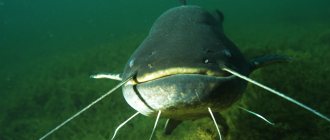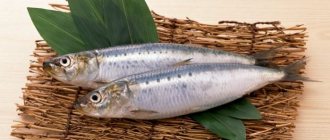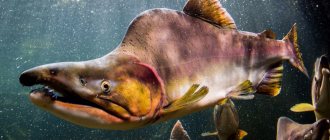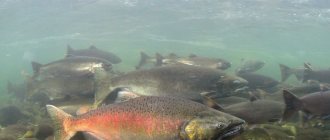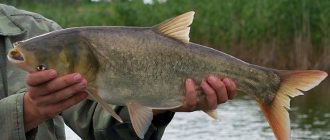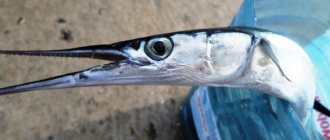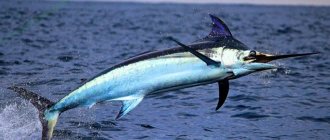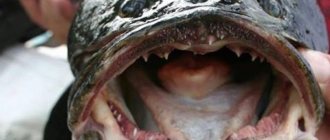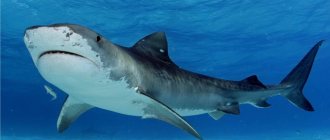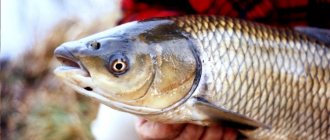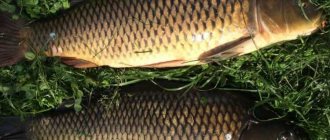Bleak (bleak, sebel) is a small, agile, agile freshwater fish that lives almost everywhere in water bodies in the middle zone. Characterized by a pelagic lifestyle.
Bleak, apparently, is one of the fish that has a lot of other names depending on the zone of its habitat. There are shackley and shackley and buckley/baklya, and sebil and sybil, and selyavka and sintya... A relatively complete list can be found below, bleak is small, but a very diverse fish, including in its nicknames.
Description
| Class: | Ray-finned bony fish |
| Squad: | Carp-like |
| Family: | Carp |
| Subfamily: | Dace-like |
| Genus: | Bleak |
| View: | Common bleak |
| Scientific name: | Alburnus alburnus |
| Habitats: | river or stream, pond, lake and reservoir. |
| Enemies | perch, pike, asp, chub, pike perch and waterfowl. |
| Nutrition | omnivore, prefers animal food, no seasonal preferences. |
| Body length | from 12 to 15-18 cm, trophy specimen 25 cm. |
| Weight | up to 60 g, trophy specimen – 108 g |
How and what to catch verkhovka: real fishing with video
The time for fishing is mainly the warm season, when schools of fish are clearly visible on the surface. For fishing, nets with small cells, nets, and homemade spiders are used.
In open water, it is enough to feed and you can collect the catch with nets and catch with a float rod. As bait they use: crackers. Dry food for aquarium inhabitants.
When fishing in winter, the main difficulty is to determine the habitat of the school. Focus on areas not covered with ice or where there is a slight current. There they gather to feed on plankton.
In winter you can’t do without bait. You shouldn't feed too much. If the flock is close, it approaches immediately. The gear chosen is a light fishing rod with a sensitive nod and a thin, small hook. The nozzle is the smallest bloodworm.
Catching a top-smelting fish with a float rod:
Verkhovka is a popular live bait for large freshwater inhabitants: perch, pike, chub. The fish is small and dies quickly when hooked, so the angler needs special game skills to attract prey.
Other names
The bleak fish (top-water fish, top-melting fish) is the only one that has its own, local name in different regions. There are at least 20 names found on the territory of the Russian Federation alone:
- in the Astrakhan region it is called twitch;
- in Penza - Kalinka;
- Saratov residents call fish bakleshka;
- the inhabitants of the Kama - shakleya, Vyatka - shakleya;
- Upper Volga - mudflow;
- Oki - shekelei;
- Gums and Seimas - sebel fish;
- Dniester - seamstress;
- The Urals call him a groom.
Photo: bleak fish
Fishing in other places:
- buckwheat;
- buckley or buckley;
- I will bite the fish;
- silyavka;
- sentyu fish or shinchu.
There are also such names for bleak:
- sybil fish;
- liar;
- tickling;
- whitefish;
- centepka.
Price
Bleak is a fish that is not of commercial interest, but is nevertheless caught in limited quantities and offered to the buyer. At the same time, he performs in different roles.
To create a solid body of water that could be of interest to fishermen, it is not enough to improve, for example, a lake. It needs to be stocked. Carrying out this work, ichthyologists release various species of fish into the lake, artificial reservoir. The biological balance will be maintained if common bleak is among them.
For stocking purposes, bleak is sold live. The cost of fish depends on the sales volume, ranging from 500-750 rubles per kg. When released into a lake or pond, bleak grows and reproduces quickly. Following this, the number of predatory fish will increase.
But not only pike and pike-perch love bleak; people enjoy using it. Large and medium-sized fishermen are not distracted by such an insignificant object. Small farms catch bleak.
The most common way of supplying bleak to trade is in dried form. This small dried fish costs about 500 rubles. per kg. It is unlikely that you can buy it at the nearest fish store. But this fish is constantly offered on the Internet.
Erroneous names
Out of ignorance, sometimes a bleak is given a name that belongs to another fish.
- Samarans call it chebak, but this is the name of the Siberian roach.
- In the Orenburg region they call it white-eye, but this name belongs to the sapa fish.
- It is also incorrect to call bleak sprat, because this is the name given to Black Sea or Baltic sprat.
- Buckleya is often confused with the top-melting fish and the bystryanka, because they are very similar.
- It is more correct to call bitter fish a sinyavka, and oatmeal fish as a verkhovka.
Bite from dawn to dusk
Contrary to the well-established opinion among fishermen that the best bite can always be found only at dawn or early dawn, this has nothing to do with catching bleak. You can cast your fishing rods at lunchtime, or come to the pond right after work.
If it’s bleak fishing season, you won’t be left without fish! This type of fishing is especially suitable for beginner fishermen and children.
Photos of bleak as a lucky trophy can be seen on many schoolchildren’s pages on social networks.
What does bleak look like?
In appearance it is similar to many small fish, but with its own differences:
Photo of bleak
- the color of the bleak is camouflage - the upper part is dark, olive in color, the bottom and sides are light silver;
- cycloid scales are silvery with a metallic tint and shine like a mirror, but the darker the water, the duller the color of the scales;
- a torpedo-shaped or spindle-shaped body, compressed at the sides, adapted for rapid swimming in dense water;
- the caudal fin is dark, with a deep notch, the dorsal and belly are ashy or yellowish in color;
- On the small pointed head, bulging eyes with large dark pupils stand out.
A striking difference of the bleak is the upward-curved mouth on the extended lower jaw.
Differences between verkhovka and bleak
These equally small fish are distinguished by size, behavior and other characteristics.
| Comparison details: | Bleak | Verkhovka |
| Body Length(cm): | 12-15 | 6-9 |
| Scales on the lateral line (pcs.): | 52-55 | 12-14 |
| Mouth: | due to the lower jaw, it is pushed forward and bent upward. | oblique, directed upwards. |
| Head: | with a pointed muzzle. | large, cone-shaped, rounded snout. |
| Body: | tall and flattened laterally. | The body is narrower, similar to a bar. |
| Where it swims: | in the thickness, rarely rises to the upper layers of water | near the surface in quiet and not deep places where there is a sandy bottom |
| Back color: | dark olive | green |
| Side line: | poorly expressed | blue color, clearly visible |
Differences between bleak and verkhovka
The difference between bleak and dace
- The body of the bleak is shorter and lighter.
- The mouth is directed upward, in contrast to its semi-lower location in the dace.
- The back is olive, not blue.
The fish also differ in their fins: those of the dace are gray, of a moderate red-yellow hue. The anal and dorsal fin are notched. The bleak has an ashy or slightly yellow color, with a cutout, and a strong one, only the caudal fin.
Appearance and features
Photo: Bleak fish
So, the common bleak is a small fish, the maximum length of which can reach up to 15 cm, the average weight of a bleak is 60 grams, but there are larger specimens (about 100 grams). It has been noticed that the river bleak is slightly shorter in length than the one that lives in the waters of lakes.
As already noted, the bleak has an elongated, low body, the ridge of the fish is almost straight, and the abdomen is slightly convex. The small head of the fish has a pointed shape, the eyes of the bleak on it seem large, having large dark pupils. The bleak's mouth is equipped with pharyngeal teeth growing in two rows; they have a curved shape and uneven edges. At the end of the fish tail, a large, dark-colored fin with a deep notch is clearly visible. The remaining fins have ashen or slightly yellowish tints.
Video: Bleak
The color of the bleak is called pelagic, i.e. it is characterized by a dark dorsal region and a light bottom; this camouflages the fish, counteracting both bottom predators and birds that attack from the air. Bleak has metallic-colored scales, which are characterized by a mirror shine. In the dorsum there is a noticeable grayish-blue, slightly olive tint, and the belly is always light. The most recognizable sign of bleak is the sticky, silvery fish scales that immediately stick to your hands when you hold the fish in them. Apparently that's why they called it that.
Interesting fact: The scales of the bleak hold on very weakly, instantly being removed upon any contact with anything (plants, stones), so cleaning this fish is very easy, you can simply grind it together with salt in some container, and then rinse with water.
Types of bleak
There are no more than 45 species in the bleak genus. They are distinguished by their habitat and subtle external signs. The main difference is the number of scales that cover the lateral line. There are from 45 to 55 of them on the body of the common bleak, the main representative of the species.
Azov-Black Sea Shemaya
Some subspecies have a shortened nose and dark stripes on their sides, while others have a brightly colored back. River bleaks are smaller and longer than lake inhabitants.
| There are: | Difference from ordinary bleak | Fish body length (cm) | Weight (g) | Number of scales on a line |
| Danube bleak or Caspian shemai | by fin color | 15-30, sometimes 40 | over 200 | 57-70 |
| Caucasian bleak | difficult to distinguish | no more than 10 | up to 100 g | 41-45 |
| Azov-Black Sea Shemaya | pectoral fins are orange, the body is wide | up to 35 | 200-250, sometimes 800 | 64-70 |
Spawning and lifespan
- 2-3 year old bleaks are already becoming sexually mature.
- Bleak lives up to 6-8 years. If there are many predators in the reservoir, it rarely lives to be 3-4 years old, as it is a desirable hunting object for them.
By the beginning of April, the fish begin to prepare for spawning and move to calm shallow water with bottom vegetation. Sometimes bleak spawn on sand and pebble shallows and rocky soil.
Bleak spawning begins when the water warms up to more than 15 degrees.
Females lay 10-11 thousand eggs, which the male immediately fertilizes. The duration of the spawning period is 4 days, but with breaks at night. It is interesting that the older fish begin to spawn first, then, after 1.5 weeks, the turn of the young bleaks comes.
Where does it live?
Bashkleika is found in all bodies of water where there are no strong thickets of aquatic vegetation. Also, the place where the bleak lives is characterized by the absence of a strong current. Can adapt to bodies of water with different temperatures. Found in cold and warm water, it quickly adapts to changing conditions.
Yandex pictures
Bucklya feels comfortable in calm lowland rivers. Mandatory conditions for those reservoirs where shackley lives are:
- gentle banks;
- winding riverbed;
- a large amount of oxygen in water;
- lack of dense aquatic vegetation;
- clear and clean water.
Sybil will not live in lakes with stagnant waters and in reservoirs with strong currents. Today it can be found not only in the territories of Russia, it is widespread in many countries of the post-Soviet space. Many bleaks inhabit rivers that are part of large seas. There are especially many of these fish in the pool:
- Black Sea;
- Caspian Sea;
- Baltic Sea;
- Sea of Azov.
The reservoir fills up very quickly after stocking. Bleak needs a lot of sunlight; it actively seeks it, rising to the surface of the reservoir and sparkling with its small scales. In the evening, it moves to shallow water areas, and when dawn comes, it swims to sunny areas away from coastal areas. Does not like flowing areas. Arranges housing for himself in quiet places. It also feels comfortable in the pond.
Catching bleak
You can catch bleak because of the excitement of sport, and because of the tasty and healthy meat. In both cases, fishing turns out to be exciting, because the fish bite greedily and aggressively, but it is often difficult to hook it. For effective fishing, you should stock up on light tackle, the right bait and bait. With proper skill and patience, even a beginner will not be left without a catch.
Where to find
Preferred places where the likelihood of encountering bleak is highest:
- moderate flow of lowland rivers;
- flowing lakes;
- reservoirs;
- streams;
- brackish estuary water;
- slow current near a pier or bridge.
The bleak is not afraid of people; it swims close to swimmers and fishermen in a boat. Near the shore, it grazes at a depth of up to 1 m. After hibernation, it chooses illuminated and warmed places with an abundance of vegetation.
It is most likely to be found in “fast waters” and in the middle current, and the depth of such an area should be about 1 meter. Holes are acceptable, but shallow water is best avoided.
You should not look for bleak in fast-flowing mountain rivers, in stagnant lakes and ponds, or in heavily overgrown reservoirs.
Lifestyle
From early spring to late autumn, bleak (sebel) stays at a depth of up to 70 cm from the surface of the water. It leads a gregarious lifestyle, so it moves around the reservoir in large flocks in search of food. In conditions where there are predatory fish in the reservoir, bleaks form small schools, which are not so noticeable to predators and are more maneuverable. Although the fish is not big, it has good sprinting performance, which allows it to survive in such difficult conditions.
Bleak chooses clean and deep areas to quickly escape from a predator's attack. Therefore, bleak does not like areas overgrown with aquatic vegetation, which is an obstacle to the rapid movement of this fish.
To find food for itself, the bleak rises closer to the surface of the reservoir, where it grabs insects in flight or tries to knock them down with splashes. At the same time, she jumps high out of the water. It behaves the same way on cloudy days, when flocks of midges and other insects fly near the surface of the water due to their wings becoming heavy from moisture. When for some reason insects find themselves in the water, they immediately become food for both bleak and other fish. With the arrival of real cold weather, bleak (sebel) moves to significant depths. In winter, bleak is in a state of suspended animation and waits out the cold in wintering pits next to other representatives of cyprinids. It remains in this state until the freeze-up.
Necessary gear and bait
Bleak is a small fish, so to catch it you should choose light equipment and a float rod. Fly fishing tackle or light spinning rod with a fly or fall bait on a hook is suitable.
- The thickness of the fishing line is 0.10 mm, sometimes they take 0.15, but no more.
- The float is 1 g, a goose feather is also suitable. The main thing is that the antenna protrudes above the water by a fourth or third of the float, and the bottom is painted dark.
- A pair of ordinary lead “pellets” is suitable for the weight.
How to catch sebel
Where can I find bleak?
Bleak is found in many bodies of water. Prefers flat rivers with moderate currents. Found in flowing lakes, reservoirs and small streams. The selyavka is able to withstand the brackish water of river mouths. In slow currents it groups near piers and bridges.
It is not afraid of people: it swims up to places for swimming and resting. It does not swim far from the shore: in the coastal zone it must be looked for at a depth of 70-100 cm. In spring, bleak must be looked for in illuminated and warmed places, especially where there is vegetation.
The fish does not inhabit mountain rivers with very fast flows, stagnant lakes and ponds and overgrown reservoirs.
Sebel is a small fish, but ubiquitous in the middle zone, and therefore interesting to catch.
Advice! To find out whether the sybil is present in the reservoir, just look closely at the shore, since it prefers to feed along the shore. If you throw a piece of bread into the water, the flock will immediately expose itself.
Necessary gear
As a rule, when catching bleak, a regular float rod is used. Important! The tackle should not be heavy:
- The main line should be no thicker than 0.15 mm, on average its thickness is 0.12-0.2 mm, and the size of the leader line can vary from 0.08 to 0.1 mm. The diameter of the leader should be larger than the main line. Its length can be 15-30 cm.
- The hook should be no larger than No. 14 in accordance with the international classification. The shank of the hook should be elongated.
- pellets as weights, with the largest being installed first from the tip of the rod.
- Floats are used with a long antenna and a short keel, weighing from 1 to 3 grams. The antenna should protrude a quarter or a third above the surface of the water. The most proven floats are elongated and short teardrop-shaped ones. Please note that the floating object (the lower part of the float) should be chosen in a dark color, because this fish “hits” bright colors.
A comfortable and lightweight classic fly rod with a length of 2.5 to 5 meters is used. The plug fits well. Fishermen often use long reeds, cut directly on the pond, instead of fishing rods. You can also catch bleak using a net.
All equipment elements should be as light and thin as possible.
Autumn bleak fishing:
How to fish: technique, tactics, bait and advice from fishermen
Experienced fishermen, in order to attract the attention of the riding fish, scoop up water with their palms and throw it to the place of the float. In accordance with their recommendations, during a break in fishing or while changing gear, complementary feeding should not be stopped.
Pot-bellied bashley is a decent catch, especially for beginners
The bleak bites periodically.
It is interesting to know that the bait is thrown a little higher upstream, and the gear - lower.
When the bite stops, it is necessary to reduce the intensity of the bait, after which the bite will resume. When the bite increases, they do the opposite.
The gear should not be cast deep. It is much more effective to catch bleak in the spring, in the evening and morning hours. You should cast the fishing rod noisily and sharply: the top swimmer will react to the splash and rush towards it.
Attention! The buckeye bites sharply, so the angler must have an immediate reaction.
In cold weather, bleak is caught well at the end of winter, during the thaw period. Finding it at this time is not easy: it can live at the bottom, at the edge of the ice or in the middle of the depth. You can't do without complementary foods here.
The fish is not picky. The bait for bleak should be small in size. The use of the nozzle depends on the season:
- In the spring, the silyavka is lured with a small worm, caddisfly, bloodworms and maggots, which should be white. The fish does not consume plant food at this time.
- In the summer , bleak feeds on plant products; even bread crumbs will be pecked. You can use semolina mash.
- In autumn , the fish bite weakly, so the diet should be comprehensive, including food of plant and animal origin. Maggot with pearl barley works well.
- In the winter season, burdock and bark beetle larvae serve as excellent bait for catching bashklei.
How to catch a large sebeli:
Lure
It is necessary to use bait in order to keep the fish in a specific place.
When purchasing bait mixture, you can choose any brand, but it is important that the bait be finely dispersed. In order for the mixture to create cloudiness, it must be over-moistened during the mixing process. You can add milk powder in the amount of 100 grams per 1 kg of bait.
You can make the bait yourself. Bran and breadcrumbs are mixed. They should first be ground in a coffee grinder. To attract fish, the mixture includes an aromatic additive: strawberry, pear, vanilla and dill oil. Water is poured into the resulting bait and balls are formed from it.
The colder the air temperature, the more bleak needs food of animal origin. At this time, the bait is mixed with bloodworms.
Catching bleak on a fly rod - video from experts:
Use in cooking
Bleak fish is suitable for salting, drying and smoking. It is also fried, stewed and used to make canned food or as a filling in pies.
Taste qualities
As a food product, bleak is not widely valued now, but it has a pleasant-tasting meat, which is probably why it is called king fish. Bleak meat is moderately fatty and has a delicate taste. Montenegrin restaurants even serve fried bleak as a delicacy. Many people like dried fish. Especially if the time of fishing is August or September, it is believed that it is during this period that its meat is most healthy and tasty.
Calorie content of meat
- Bleak, with a meat fat content of 12%, is a dietary food product.
- Fried dishes contain 145 calories, boiled ones - only 95. So bleak meat is useful for people who are losing weight and those who do not want to gain weight.
- In addition, fish is rich in minerals and substances necessary for the human body. It is especially beneficial for its content of magnesium, zinc, potassium, molybdenum and fluorine.
How to quickly and deliciously prepare bleak
The bleak quickly dies and begins to deteriorate! Therefore, fish intended for drying are immediately thrown into a container with salt after being removed from the hook. Arriving home, they immediately hang it on a thin wire in a ventilated room or simply under a canopy.
It is recommended to use fresh fish for cooking!
Fried bleak recipe
- The fish is rubbed with fingers or used to remove scales, then washed, the entrails are removed and the head is cut off.
- Wash again with cold water, dry and lightly add salt.
- The finished fish is rolled in semolina or bread crumbs.
- Fry in a hot frying pan in vegetable oil until crispy.
Fishing calendar
in winter
The beginning of winter from freeze-up to the first Christmas frosts. Then there is practically a pause until the ice breaks up. In the beginning of March. When the bleak reactivates
in spring
Starting from the complete opening of the rivers and until the start of spawning. At this time of year, bleaks enjoy an excellent appetite after wintering - although its nutritional value after a month of pestilence in pits and famine is questionable.
In summer
The entire period from mid-May to the end of August can be considered summer. Most often, in the summer, bleak is taken on a float rod with a cast from the fishing spot 8-10 meters or on a bottom. Groundbait is desirable. And you always need to focus on the direction of the wind and current.
in autumn
The entire period from the end of August until freeze-up is a period of active zhora on the eve of winter with its semi-anabiotic state.
